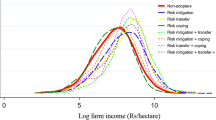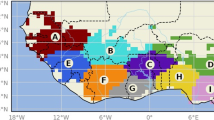Abstract
Smallholder farmers in dryland areas, including the Arab region, face many risks, including those relating to weather and markets. While risk taking is necessary for economic development, many risks are so severe that responses to them entail long-term losses. Social risk management is a family of tools that facilitates efficient risk management and can help eliminate risk-related poverty traps. Safety nets form an important part of the social risk management toolkit; it is therefore important to evaluate their effectiveness. This review has identified several considerations for the design and implementation of safety nets to improve food security among small-scale producers in dryland areas. The main conclusions are: safety nets must be part of an integrated risk management strategy; they should be designed to contribute to long-term agricultural growth; and more effort is needed to establish efficient risk management mechanisms prior to crises.

Similar content being viewed by others
Notes
Part of the commodity price run-up in 2008 was due to increased energy prices, and any analysis of impacts on marginal net-selling households must include an assessment of the impacts of this cost squeeze.
The 2008 price increase was accompanied by increased input costs. Small-scale farmers (who predominate in Arab countries) underwent a cost squeeze and many did not benefit from price increases.
Many Arab countries use generalized food subsidies to moderate price fluctuations and lower prices to consumers. Evaluations show these to be inefficient at reaching the poor. In Egypt, the wealthiest quintile of consumers receives more than three times the subsidy that the poorest families receive and in Morocco, more than 90% of the generalized food subsidy goes to the non-poor (Yemstov 2008). Ahmed et al. (2001) also show the fiscal costs of the Egyptian system to be quite high.
When such programs are used in the midst of a crisis, questions of how they can be funded are paramount. During 2008, most governments were short of ready capital. Such fiscal constraints imply two outcomes: (i) governments seek actions that cost the least (hence, the reliance on trade-related measures); and (ii) governments request international assistance. In the latter case, some control is lost over the design of the intervention.
PROGRESA used a two-tier process and identified the poorest communities, and within these communities, the poorest households. The program could be ramped up in a short-term emergency by lowering the threshold for communities to participate (broadening participation across villages) or lowering the household threshold (broadening participation within villages). Two challenges exist in short-term emergencies: (i) if relief is short term, some of the benefits of conditionality will be lost; and (ii) targeting criteria may vary. The chronic poor are usually targeted in conditional cash transfer programs, but emergency targeting should also include the transitory poor, although these are likely to have different attributes requiring a different ideal targeting process.
This was a means-targeted program that was supposed to be a conditional cash transfer. However, due to deteriorating conditions and the inability to monitor compliance, the conditionality was quickly removed.
References
Adato, M., & Hoddinott, J. (2007). Conditional cash transfer programs a ‘magic bullet’ for reducing poverty? 2020 Focus Brief on the World’s Poor and Hungry People. Washington: International Food Policy Research Institute.
Ahmed, A. U., Bouis, H. E., Gutner, T., & Löfgren, H. (2001). The Egyptian food subsidy system structure, performance, and options for reform. Research Report 119. Washington, DC, USA: IFPRI.
Alston, J., Norton, G. W., & Pardey, P. (1995). Science under scarcity. Ithaca: Cornell University Press.
Alwang, J., Siegel, P. B. & Jorgensen, S. L. (2001). Vulnerability: a view from different disciplines. Social Protection Discussion Paper No. 0115. Washington, DC, USA: World Bank.
Anonymous. (2009). World Bank expands response to food price crisis to $2 billion. News and Broadcast, 21 April 2009. Washington, DC: World Bank. http://web.worldbank.org/WBSITE/EXTERNAL/NEWS/0,,contentMDK:22150918~pagePK:64257043~piPK:437376~theSitePK:4607,00.html. Accessed 21 April 2009.
Aw-Hassan, A., Majid, A., Alwang, J., Norton, G. W., & Kaitibe, S. (2009). Opportunities for poverty reduction through wheat research in Northern Syria. Paper presented at Annual Meetings of Agricultural and Applied Economics Association, Milwaukee, USA, 27 July 2009. Milwaukee, WI, USA: Agricultural and Applied Economics Association.
Carter, M., & Barrett, C. B. (2006). The economics of poverty traps and persistent poverty: an asset-based approach. Journal of Development Studies, 42(2), 178–199.
Cavendish, W. (1999). Incomes and poverty in rural Zimbabwe during adjustment: the case of Shindi Ward, Chivi communal area, 1993/4 to 1996/7. Oxford: Centre for the Study of African Economies.
Devereux, S., Sabates-Wheeler, R., Tefera, M., & Taye, H. (2006). Ethiopia’s productive safety net programme: trends in PSNP transfers within targeted households. Final Report. Sussex: IDS and Indak International.
de la Brière, B., & Rawlings, L. B. (2006). Examining conditional cash transfer programs: a role for increased social inclusion? Social Protection Discussion Paper No. 0603. Washington, DC, USA: World Bank.
Fafchamps, M., Udry, C., & Czukas, K. (1998). Drought and saving in West Africa: are livestock a buffer stock? Journal of Development Economics, 55, 273–305.
Grosch, M., del Ninno, C., Tesliuc, E., & Ouerghi, A. (2008). For protection and promotion: design and implementation of effective safety nets. Washington: World Bank.
Holzmann, R., & Jorgensen, S. (2000). Social risk management: a conceptual framework for social protection and beyond. Social Protection Discussion Paper No. 6. Washington, DC, USA: World Bank.
Maluccio, J. A. (2005). Coping with the coffee crisis in Central America: the role of the Nicaraguan Red de Protección Social. FCND Discussion Paper 188. Washington, DC, USA: International Food Policy Research Institute.
Mrabet, R. (2002). Wheat yield and water use efficiency under contrasting residue and tillage systems in a semiarid area of Morocco. Experimental Agriculture, 38, 237–248.
Mrabet, R. (2008). No-tillage systems for sustainable dryland agriculture in Morocco. Rabat: Institut National de la Recherche Agricole.
Nasr, M. (1999). Assessing desertification and water harvesting in the Middle East and North Africa: policy implications. ZEF Discussion Papers on Development Policy No. 10. Bonn, Germany: Center for Development Research.
Siegel, P. B., Alwang, J., & Jorgensen, S. L. (2003). Rediscovering vulnerability through a risk chain: views from different disciplines. Quarterly Journal of International Agriculture, 42(3), 351–370.
Skofias, E. (2005). PROGRESA and its impacts on the welfare of rural households in Mexico. Research Report No. 139. Washington, DC, USA: IFPRI.
Thomas, D., Beegle, K., Frankenberg, E., Sikoki, B., Strauss, J., & Teruel, G. (2004). Education in a crisis. Journal of Development Economics, 74(1), 53–85.
von Braun, J. (2008). Rising food prices: what should be done? IFPRI Policy Brief. Washington: International Food Policy Research Institute.
World Bank. (2008). Economic growth, inequality and poverty: social mobility in Egypt between 2005 and 2008. Washington: World Bank.
World Bank. (2009). Improving food security in Arab countries. Washington: FAO, IFAD and the World Bank.
Yemstov, R. (2008). The food crisis: global perspectives and impact on MENA, fiscal and poverty impact. Washington: World Bank.
Acknowledgments
The authors wish to thank Kamel Shideed, Aden Aw-Hassan, participants at the IDDC 9th International Conference on Sustainable Development in the Drylands, November 2008, Alexandria, Egypt, and comments from five anonymous reviewers.
Author information
Authors and Affiliations
Corresponding author
Rights and permissions
About this article
Cite this article
Alwang, J., Norton, G.W. What types of safety nets would be most efficient and effective for protecting small farmers and the poor against volatile food prices?. Food Sec. 3 (Suppl 1), 139–148 (2011). https://doi.org/10.1007/s12571-010-0089-9
Received:
Accepted:
Published:
Issue Date:
DOI: https://doi.org/10.1007/s12571-010-0089-9




